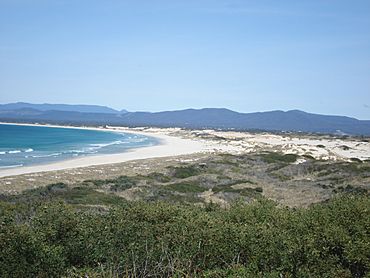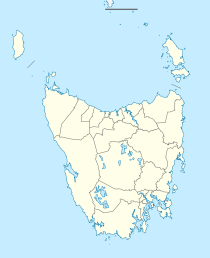St Helens, Tasmania facts for kids
Quick facts for kids St HelensTasmania |
|||||||||||||||
|---|---|---|---|---|---|---|---|---|---|---|---|---|---|---|---|
 |
|||||||||||||||
| Population | 2,206 (2021 census) | ||||||||||||||
| Postcode(s) | 7216 | ||||||||||||||
| Location |
|
||||||||||||||
| LGA(s) | Break O'Day Council | ||||||||||||||
| State electorate(s) | Lyons | ||||||||||||||
| Federal Division(s) | Lyons | ||||||||||||||
|
|||||||||||||||
|
|||||||||||||||
St Helens is the biggest town on the north-east coast of Tasmania, Australia. It sits right on Georges Bay. People know St Helens as the best place in Tasmania for game fishing. It's also famous for its delicious oysters!
You can find St Helens on the Tasman Highway, about 160 kilometers east of Launceston. Launceston is Tasmania's second-largest city. In the early 2000s, St Helens was one of the fastest-growing areas in Tasmania. By 2021, its population was 2,206 people.
St Helens is part of the Break O'Day Council. This council also includes the nearby town of Binalong Bay. St Helens has its own radio station called Star FM. You can listen to it on 93.7 MHz in town. There are many shops on Cecilia Street, including a Supa IGA supermarket and Gallery Parnella.
Contents
History of St Helens
St Helens was first used as a base for whaling in the early 1800s. Whalers hunted whales from here. Later, in the 1870s, people found tin in the areas around St Helens. This made St Helens an important shipping port for the mines. Before this, you could only reach the town by sea. After tin was found, a coach service started.
The town got its name from St Helens on the Isle of Wight in England. Today, St Helens is a popular spot for fishing, swimming, and other water activities. The town's economy mainly relies on tourism, fishing, and timber.
Early Explorers and Settlement
Captain Tobias Furneaux was the first European to explore the St Helens area. He sailed along the coast in 1773. He named the southern tip of Georges Bay, St Helens Point. By the 1830s, whalers and sealers were using Georges Bay. A small settlement grew up on the shore, and it was called Georges Bay. The local Aboriginal people were known as the Georges Bay tribe.
The first official land was given out in 1830. In 1835, the small village was renamed St Helens. It stayed a quiet port until tin was found at Blue Tier in 1874. Suddenly, the port was full of miners. More than 1,000 Chinese miners passed through the port. The tin mines did very well from 1874 until the early 1900s.
When the mines closed, many miners moved to the coast. A lot of them settled in St Helens. Over time, the port changed. Today, it has a big fishing fleet. This fleet is supported by businesses that build boats and supply ships. Recently, tourism has become very important. People love to visit for the fishing and the town's mild weather.
Modern Events and Famous People
In 2018, St Helens hosted Triple J's One Night Stand. This was a big music concert put on by the radio station Triple J. Famous bands like Vance Joy, Peking Duk, Middle Kids, Alex the Astronaut, and The Sleepyheads performed there.
Some famous musicians have lived in St Helens. These include Lee Hartney from The Smith Street Band and Tom Busby from Luca Brasi.
Environment and Climate
St Helens has a special natural environment. It also has a unique climate.
Important Bird Area
The town is next to the St Helens Important Bird Area. This area is special because it's a breeding place for many seabirds and waders. BirdLife International has identified it as an important spot for birds.
Waterfalls Near St Helens
About 35 kilometers west of St Helens, you can find the Mount Victoria Forest Reserve. Here, you'll discover the beautiful St Columba Falls. These waterfalls are about 90 meters high!
St Helens Climate
St Helens has an oceanic climate. This means it has mild to warm summers, sometimes with very hot days. Spring and autumn are mild. Winters are cool and often cloudy. Rain falls steadily throughout the year, with a bit more rain from November to March.
Because St Helens is on the east coast, its winter temperatures are warmer than most parts of Tasmania. This is due to something called the foehn effect. Summer temperatures are not as hot as inland areas, but they are still warmer than in Hobart. The hottest temperature ever recorded in St Helens was 41.8°C. This happened on 30 January 2009. It was one of the highest temperatures ever recorded in Tasmania.
| Climate data for St Helens Aerodrome, Tasmania, Australia (2001–2024 averages and extremes); 48 m AMSL | |||||||||||||
|---|---|---|---|---|---|---|---|---|---|---|---|---|---|
| Month | Jan | Feb | Mar | Apr | May | Jun | Jul | Aug | Sep | Oct | Nov | Dec | Year |
| Record high °C (°F) | 41.8 (107.2) |
35.6 (96.1) |
34.4 (93.9) |
28.4 (83.1) |
24.1 (75.4) |
19.2 (66.6) |
19.3 (66.7) |
20.9 (69.6) |
25.2 (77.4) |
29.7 (85.5) |
33.8 (92.8) |
36.8 (98.2) |
41.8 (107.2) |
| Mean daily maximum °C (°F) | 22.9 (73.2) |
22.1 (71.8) |
21.1 (70.0) |
18.6 (65.5) |
16.1 (61.0) |
14.1 (57.4) |
13.6 (56.5) |
14.3 (57.7) |
16.1 (61.0) |
17.6 (63.7) |
19.5 (67.1) |
21.3 (70.3) |
18.1 (64.6) |
| Mean daily minimum °C (°F) | 13.5 (56.3) |
13.3 (55.9) |
11.9 (53.4) |
9.6 (49.3) |
7.2 (45.0) |
5.6 (42.1) |
4.9 (40.8) |
5.3 (41.5) |
6.7 (44.1) |
8.2 (46.8) |
10.2 (50.4) |
11.8 (53.2) |
9.0 (48.2) |
| Record low °C (°F) | 4.8 (40.6) |
6.3 (43.3) |
3.1 (37.6) |
1.3 (34.3) |
0.0 (32.0) |
−1.0 (30.2) |
−0.9 (30.4) |
−1.0 (30.2) |
−0.3 (31.5) |
0.9 (33.6) |
1.9 (35.4) |
4.3 (39.7) |
−1.0 (30.2) |
| Average precipitation mm (inches) | 59.6 (2.35) |
61.6 (2.43) |
67.7 (2.67) |
53.3 (2.10) |
48.0 (1.89) |
65.9 (2.59) |
44.0 (1.73) |
55.9 (2.20) |
53.0 (2.09) |
71.2 (2.80) |
77.9 (3.07) |
59.2 (2.33) |
717.9 (28.26) |
| Average precipitation days (≥ 0.2 mm) | 8.9 | 10.3 | 10.2 | 12.3 | 13.6 | 16.8 | 17.5 | 16.1 | 12.7 | 12.8 | 12.0 | 10.9 | 154.1 |
| Average relative humidity (%) | 58 | 63 | 61 | 64 | 64 | 68 | 67 | 62 | 60 | 60 | 62 | 58 | 62 |
| Source: Australian Bureau of Meteorology (2001–present averages and extremes) | |||||||||||||
Images for kids




